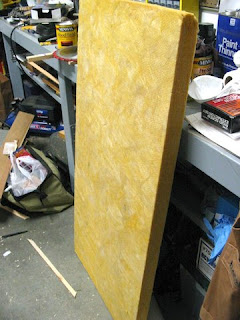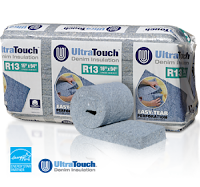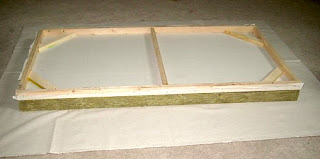Most of the excellent acoustic materials won't be found at your local Home Depot, unfortunately, so you have to search a little. Here's an excerpt from The Studio Builder's Handbook that covers what material is available and where to find it.
 |
| Owens Corning 703 compressed Fiberglass |
Owens Corning 703
As said in the previous chapters of the book, the standard for acoustic panels is Owens Corning 703, which you won’t normally find at Home Depot (see the graphic on the left).
Instead, look for a local supplier of “Industrial Insulation,” or an HVAC supplier, who should normally carry it. When asking for it at a specialty supplier, sometimes it’s called “industrial furnace insulation board.”
You can also find it online at a number of places including readyacoustics.com and gikacoustics.com among others.
703 costs approximately $12 a panel (sometimes more and sometimes less, depending on where you buy it) and comes in packs of six. Knauf ECOSE, Johns Manville, Roxul Safe and Sound, and Certainteed are the same kind of ridged fiberglass, and can be even cheaper than their Owens Corning equivalent. Just be sure that the thickness and density is the same. Try buyinsulationproducts.com.
Handling fiberglass can irritate your skin, eyes and respiratory tract, and the dust particles are so small that they can get trapped in the lungs and become carcinogenic in some people. That’s why it’s important to always wear gloves and a mask when handling it.
 |
| Rockwool acoustic material |
Mineral wool is another mineral fiber insulation product that works as a 703 or R 13 alternative.
It’s a lot less expensive than 703, and even has better absorption characteristics, but it can be a little harder to work with because it’s not as rigid.
Try Rockwool RWA45, RW3 or the ridged Rockboard 60, which costs about $35 for a package of 6 panels (see the figure on the left).
You may find Rockwool or mineral fiber at your local lumber supplier, or try online at atsacoustics.com, among other places.
Mineral wool is easily handled and does not cause any irritation to the skin, eyes or respiratory system like fiberglass does.
 |
| Ultratouch denim insulation |
Yet another alternative is Ultratouch cotton, which you might be able to find at Lowes or Home Depot. It’s about the same cost as rockwool and works almost as well, yet has none of the irritant properties of fiberglass.
You can also use it in place of R 13 or R 19 in your walls. It can also be found at sensiblesolutions.com online. What's interesting about this material is that it's basically recycled denim blue jeans.
Frames
 |
| Acoustic Panel Frame |
The wood trim can be standard wall molding that can be purchased quite easily at any hardware store or big-box discount hardware store. Typically hardwood molding can be very expensive and run from $8 to $40 and up per linear foot, but try high quality pine molding, which is both affordable and looks fantastic once it’s lacquered.
You can rent a pneumatic air hammer at your local tool and building supply company for not much money on a daily rental. If you use this nail gun with very small one inch finish nails to attach the trim to the wall panels, you’ll have a very nice look on your finished work.
Fabric
Covering acoustic panels is pretty easy in that all you need is a material that easily passes audio. This can be almost anything from burlap (probably the cheapest) to even speaker grill cloth.
The best way to test it is to blow into it, and if you feel your breath coming through the other side, it should work.
Maybe the most expensive covering is by Guilford of Maine, but it has the advantages of being acoustically transparent and flame retardant as well as being available in a wide variety of colors. You can find it online at soundaway.com, acousticalsolutions.com, noisecontrolproducts.com, as well as many others.
All that being said, cloth is available in many thicknesses and densities and there should be lots of local outlets in your area where you can purchase it at a discount. Sometimes it works better if you have thinner cloth that’s wrapped several times for a few more layers.
Try doing a test panel first to see how the cloth will work for you. You may find it best to use the thinner more affordable cloth even though you probably will have to take the extra time to attach multiple layers."
To read additional excerpts from The Studio Builders Handbook and my other books, check out the excerpts section on my website.


3 comments:
Our company http://MixmasteredAcoustics.com offers all of the acoustic insulation products Bobby mentions in his article for the most competitive prices AND Free Shipping on every item.
If I can be of help with any other acoustic treatment questions, feel free to reach out.
Thanks,
Dan Morrell
I was in Colombo Sri Lanka and the this studio I visited uses coconut husk stuffed in 2 inch by 2 inch wooden frame and closed with perforated board. It works! But needless to say that the smell are rather overpowering an a fire hazard!
Another material specifically designed for this is Tontine Acoustisorb. It comes in 3 grades and I'd recommend the Acoustisorb 3.
It's easy to handle and cut, and non-allergenic too. There are data sheets available showing the absorbtion factors against frequency so you know what to expect.
Post a Comment